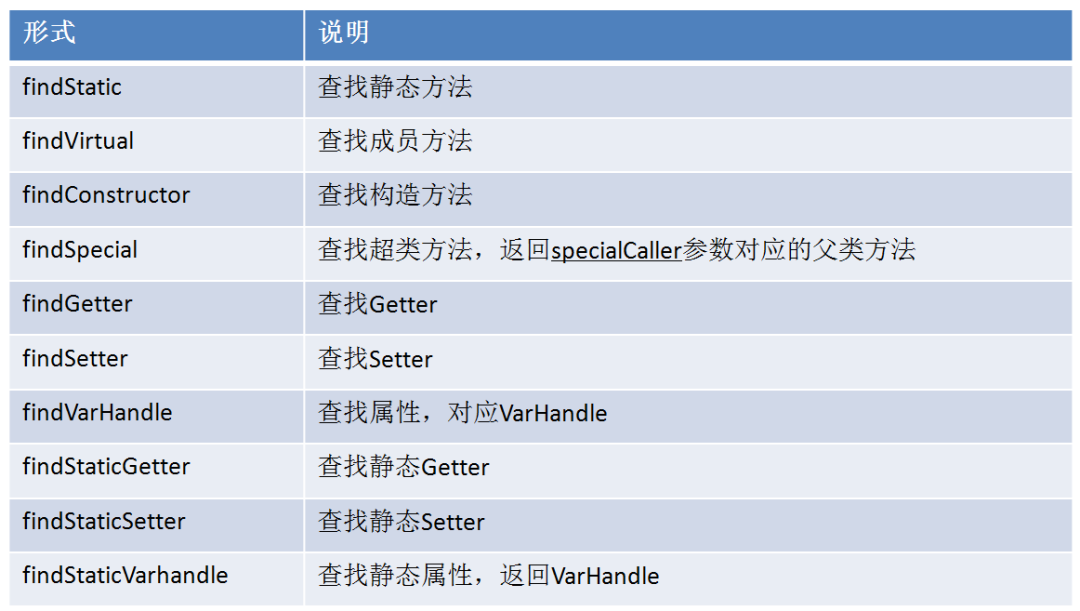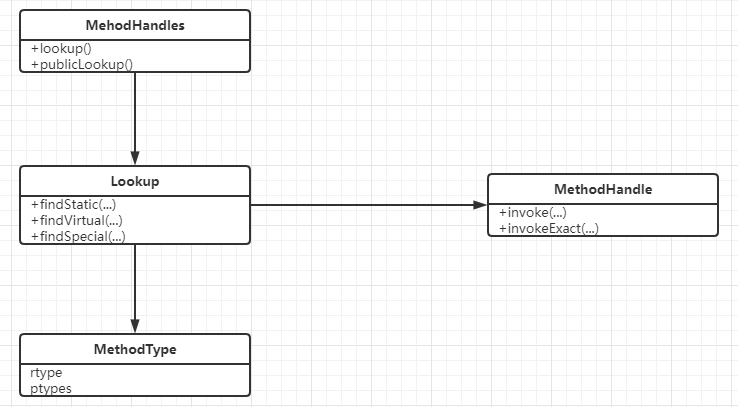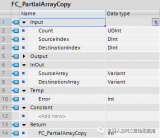反射(Reflect)作为Java最重要的一种机制,相信大家一定都很熟悉了,今天要介绍另一种和反射机制类似的方法调用机制——MethodHandle。
MethodHandle是Java7引入的一种机制,主要是为了JVM支持动态语言。
一个MethodHandle调用示例
首先,让指北君给大家演示一下最基本的MethodHandle使用。
第一步:创建查找对象:Lookup
// 获取Look用于查找方法句柄
MethodHandles.Lookup lookup = MethodHandles.lookup();
第二步:创建方法类型:MethodType
构造方法的返回值类型,参数类型
// 方法类型,描述返回值和参数,第一个参数为返回值类型,void则为void.class。第二个参数开始为被调用方法的参数类型
MethodType mt = MethodType.methodType(boolean.class, String.class, int.class);
第三步:查找方法句柄
Lookup的findVirtual查找成员方法
//查找方法句柄,参数1:调用类,参数2:方法名,参数3:方法类型
MethodHandle handle = lookup.findVirtual(String.class, "startsWith", mt);
第四步:方法调用
通过MehodHandle的invoke方法执行,并返回结果
//方法调用,参数1:实例,参数2..n:方法参数
Boolean value = (Boolean)handle.invoke("the i am in the room", "the", 0);
以上就是一个简单的调用示例。
核心代码解读
上面我们展示了一个最进本MethodHandle方式的方法调用,下面我们将对其中用到的主要类进行介绍。这些主要的类包含MethodType,MethodHandle,MethodHandles及Lookup。
MethodType
首先,我们来看看Methodtype,MethodType是用来封装方法输入输出类型的,包含方法的返回和方法的参数。MethodType构造方法为私有,只能通过MethodType提供的静态工具方法来获取实例
/**
* Constructor that performs no copying or validation.
* Should only be called from the factory method makeImpl
*/
private MethodType(Class< ? > rtype, Class< ? >[] ptypes) {
this.rtype = rtype;
this.ptypes = ptypes;
}
MethodType中常用的工具方法有:
- 大于一个参数
public static MethodType methodType(Class< ? > rtype, Class< ? > ptype0, Class< ? >... ptypes) {
Class< ? >[] ptypes1 = new Class< ? >[1+ptypes.length];
ptypes1[0] = ptype0;
System.arraycopy(ptypes, 0, ptypes1, 1, ptypes.length);
return makeImpl(rtype, ptypes1, true);
}
- 无参数
public static MethodType methodType(Class< ? > rtype) {
return makeImpl(rtype, NO_PTYPES, true);
}
工具方法都通过makeImple方法来封装MethodType实例,指北君带领大家来看看makeImple中做了哪些事情:
- 参数检查
- 返回值的类型不能为null,如果无返回使用void.class
- 参数类型不能为null,且不能为void.class
- 使用缓存表缓存MethodType实例,优化处理
- 如果非信任模式(trusted==false),则克隆参数数组
这里需要注意MethodType重写了hashCode方法,从逻辑看参数数组克隆不影响同类型的缓存机制。
static
MethodType makeImpl(Class< ? > rtype, Class< ? >[] ptypes, boolean trusted) {
if (ptypes.length == 0) {
ptypes = NO_PTYPES; trusted = true;
}
MethodType primordialMT = new MethodType(rtype, ptypes);
MethodType mt = internTable.get(primordialMT);
if (mt != null)
return mt;
// promote the object to the Real Thing, and reprobe
MethodType.checkRtype(rtype);
if (trusted) {
MethodType.checkPtypes(ptypes);
mt = primordialMT;
} else {
// Make defensive copy then validate
ptypes = Arrays.copyOf(ptypes, ptypes.length);
MethodType.checkPtypes(ptypes);
mt = new MethodType(rtype, ptypes);
}
mt.form = MethodTypeForm.findForm(mt);
return internTable.add(mt);
}
除了静态工具方法外,MethodType还有几个实例方法,主要为差异性较小的MethodType提供快速获取实例的方法。包含:
- changeParameterType
- insertParameterTypes
- appendParameterTypes
- dropParameterTypes
MethodHandle
MethodHandle为抽象类,但是里面提供了大量的原生方法,提供底层访问,也是方法调用的核心逻辑。这部分涉及MethodHandle的机制实现,对于使用功能来说指北君就不在此展开了。
@HotSpotIntrinsicCandidate
public final native @PolymorphicSignature Object invokeExact(Object... args) throws Throwable;
@HotSpotIntrinsicCandidate
public final native @PolymorphicSignature Object invoke(Object... args) throws Throwable;

调用方法
MethodHandles, Lookup
MethodHandles不是MethodHandle的实现,他提供工具用于帮助获取MethodHandle,我们主要使用到lookup(),publicLookup()
@CallerSensitive注解,可以使Reflection.getCallerClass()获取到调用lookup()方法的类
@CallerSensitive
@ForceInline // to ensure Reflection.getCallerClass optimization
public static Lookup lookup() {
return new Lookup(Reflection.getCallerClass());
}
public static Lookup publicLookup() {
return Lookup.PUBLIC_LOOKUP;
}
Lookup构造方法主要传入两个参数:
- lookupClass搜寻的类,
- allowedModes:许可模式。
最后,通过Lookup的findXXX获取到MethodHandle,详细说明见下表:

查找方法
小结
关于MethodHandle的基本使用就基本讲完,这里附上一张类图便大家理解:
-
参数
+关注
关注
11文章
1838浏览量
32252 -
代码
+关注
关注
30文章
4791浏览量
68673 -
Method
+关注
关注
0文章
9浏览量
7273 -
JVM
+关注
关注
0文章
158浏览量
12236
发布评论请先 登录
相关推荐
gpio示例调用流程
求助,请问有没有UM2262调用加密库的具体示例?
浅谈C、C++ 和 ARM 汇编语言之间的调用
python代码示例之基于Python的日历api调用代码实例

API-Shop-OCR-营业执照识别API接口Python调用示例代码说明

移动数据的编程示例





 MethodHandle调用示例
MethodHandle调用示例














评论